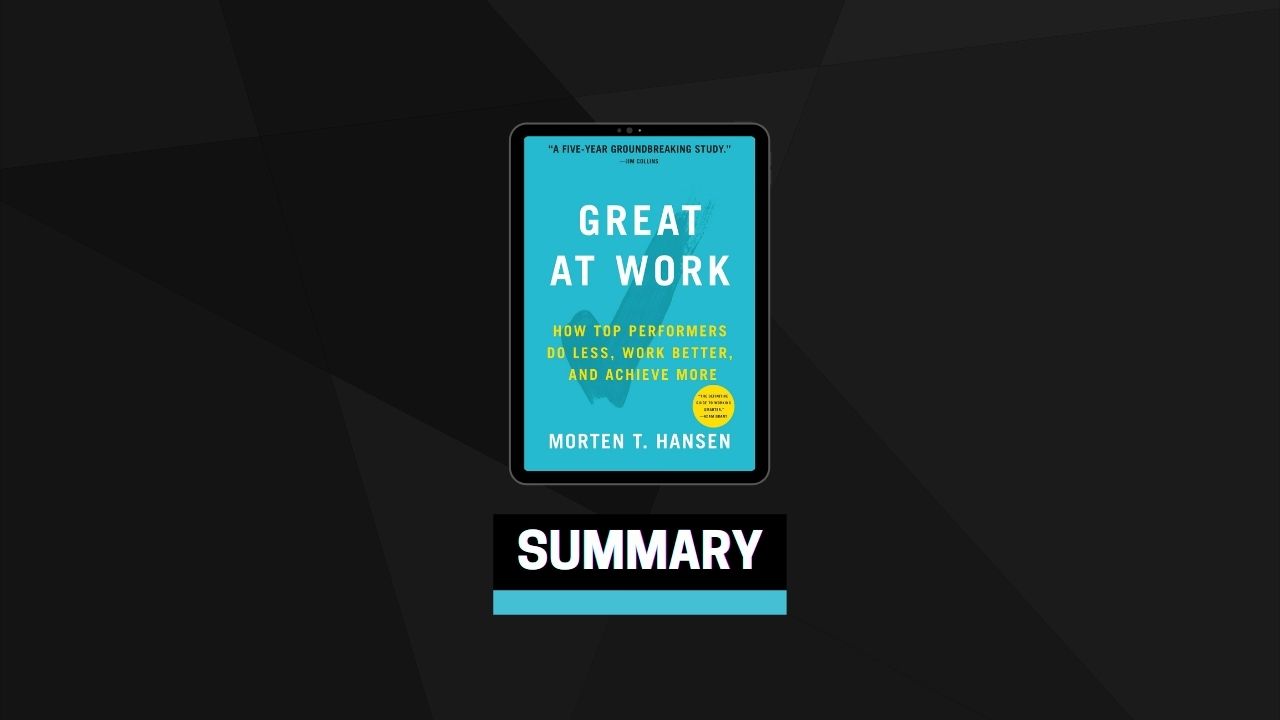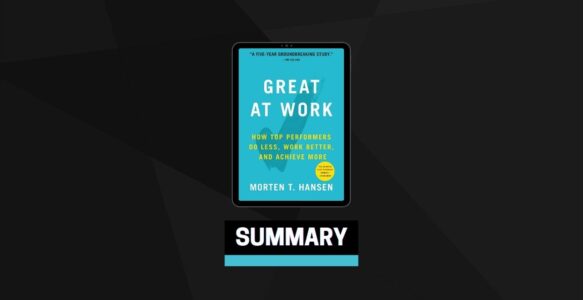Two: Do Less, Then Obsess
A study found people who chose a few key priorities and then made huge efforts to do terrific work in those areas scored on average 25 percentage points higher in their performance than those who pursued many priorities. “Do less, then obsess” was the most powerful practice among the seven discussed in this book.
“Doing more” creates two traps. In the spread-too-thin trap, people take on many tasks, but can’t allocate enough attention to each. In the complexity trap, the energy required to manage the interrelationship between tasks leads people to waste time and execute poorly.
There are three ways you can implement the “do less, then obsess” principle:
- Wield the razor: Shave away unnecessary tasks, priorities, committees, steps, metrics, and procedures. Channel all your effort into excelling in the remaining activities. Ask: How many tasks can I remove, given what I must do to excel? Remember: As few as you can, as many as you must.
- Tie yourself to the mast: Set clear rules ahead of time to fend off temptation and distraction. Create a rule as trivial as not allowing yourself to check email for an hour.
- Say “no” to your boss: Explain to your boss that adding more to your to-do list will hurt your performance. The path to greatness isn’t pleasing your boss all the time. It’s saying “no” so that you can apply intense effort to excel in a few chosen areas.
Redesign Your Work
A statistical analysis of 5,000 managers and employees demonstrates that those who redesigned their work performed significantly better than those who didn’t.
If you work up to 50 hours, performance improves as you add more hours. Beyond 50 hours, the benefit of adding more hours starts to wane. Beyond 65 hours, adding more hours causes performance to decline. Outworking others is not a clever strategy.
Good redesigns create more value—the benefits work activities bring to others. That outside-in view is very different from traditional, inside-out ways of setting goals, tasks, and metrics. People can achieve their goals and be very productive, yet produce zero value.
Explore five ways to redesign work to create value:
- Less fluff: eliminate existing activities of little value
- More right stuff: increase existing activities of high value
- More “Gee, whiz”: Create new activities of high value
- Five star rating: improve quality of existing stuff
- Faster, cheaper: do existing activities more efficiently.
Don’t Just Learn, Loop
Devote fifteen minutes a day—yes, just fifteen. A statistical analysis of 5,000-person dataset showed that people who applied the learning loop perform much better than those who didn’t.
To learn well at work, we must overcome important challenges that people don’t face when trying to master skills in sports, music, chess, and memory tests (the areas where most research on deliberate practice has been conducted).
The Learning Loop is an approach to learning while you perform your daily work: you try out a new approach in a small way (e.g., how you ask a question in a meeting), then measure the outcome, then get quick feedback, then tweak your approach based on that feedback (e.g., ask the question differently).
Effective learners break an overarching skill into micro-behaviors: they are small, concrete actions you take on a daily basis to improve a skill. The action shouldn’t take more than fifteen minutes to perform and review, and it should have a clear impact on skill development.
P-Squared: Passion and Purpose
Many people either follow their passion, or they ignore their passion. But as research shows, the issue of achieving passion at work is not a matter of “following” or “ignoring,” but rather of “matching.”
Managers and employees who matched passion and purpose performed far better than those who didn’t. They were likely to place 18 percentile points higher than those who didn’t in a 5000-person dataset.
There are three ways to expand your passions and sense of purpose:
- Discover a new role. You can likely find that match right where you are; you don’t have to leap to another profession. Seek a new role within your existing organization that better taps your passions and gives you a stronger sense of purpose.
- Expand the circle of passion. Feeling passionate about work isn’t just about taking pleasure in the work itself. Passion can also come from: success, creativity, social interactions, learning, and competence. Expand your circle of passion by tapping into these dimensions.
- Climb the Purpose Pyramid. Find ways to add more value
taking care that your contributions don’t cause harm. Second, pursue activities that are personally meaningful, no matter what others think. It helps to reframe one’s job to experience the significance it might just hold for you. Third, pursue activities that have a clear social mission.
Forceful Champions
In a 5000-person dataset, forceful champions overall were likely to score a substantial 15 percentage points higher in their performance ranking than those who didn’t inspire or use smart grit.
Forceful champions use a variety of behaviors to arouse emotions and inspire coworkers to support their efforts:
- They make people angry about today and excited for tomorrow.
- They show and don’t just tell, using striking photos and demos to evoke intense emotions.
- They make people feel purpose, connecting daily tedious work to a grander purpose.
Forceful champions display smart grit to break down opposition and garner support for their projects:
- They consider the perspective of opponents (“standing in their shoes”), tailoring their tactics to address opponents’ specific concerns and agendas.
- They confront opponents, when needed.
- They make concessions they can live with to appease opponents.
- They co-opt opponents, so that they, too, feel a sense of ownership.
- They exert pressure by mobilizing people to advocate on their behalf.
Fight and Unite
Much of a team’s joint work occurs in group meetings. Your team’s effectiveness and your own individual performance therefore hinge on the quality of those meetings. Yet most people—69 percent according to one study—complain that their meetings aren’t productive.
Many people struggled with two important aspects of team meetings. Some failed to hold rigorous “fights” or debates in which they explored ideas and scrutinized assumptions. Some also failed to commit to decisions once they were made and to work hard to implement them (to unite as a team). In either case, team meetings suffered, and an employee’s individual performance diminished.
To have a productive fight in meetings, pursue the following strategies, either as leader or participant:
- Maximize diversity, not talent
- Make it safe to speak up
- Prod the quiet to speak
- Show up as an advocate, not a salesperson
- Ask nonleading questions.
To improve team unity, try the following:
- Ensure everyone has a voice (being heard creates buy-in)
- Commit, especially when you utterly disagree
- Confront the prima donna
- Sharpen the team goal
- Stop playing office politics and get behind decisions.
The Two Sins of Collaboration
Organizations and employees struggle with twin sins: undercollaboration and overcollaboration. Some people talk too little across teams and departments, and some people talk too much. To avoid the extremes of too little or too much collaboration, top performers discipline collaboration: they carefully select which collaboration activities to participate in (and reject others), and then follow specific rules to make the chosen activities a success.
People who practiced disciplined collaboration placed 14 percentage points higher in the performance ranking than people who didn’t. Women benefited more than men.
Disciplined collaboration consists of the following five rules:
- Establish the business case—a compelling reason—for any proposed collaboration initiative, small or large. If it’s questionable, say no.
- Craft a unifying goal that excites people, so that they prioritize this project.
- Reward people for collaboration results, not activities.
- Commit full resources—time, skills, and money—to the collaboration. If you can’t obtain those resources, narrow its scope or kill it.
- Tailor trust boosters—quickly—to specific trust problems in the partnership.
Small Changes, Big Results
You can start small on each of the seven practices that make up the work-smart framework in this book. Pick just a few small steps, and start practicing. If you’re a young professional looking to move up in your company, apply the learning loop to improve just one skill at a time—say, prioritizing and becoming better at saying “no.” Over time, you’ll find that you’re working fewer hours, because you’re working on the right things in the right way. That frees up time you can spend outside of work, giving you a better work-life balance, less chance of burnout, and higher job satisfaction.
Get started with small steps and keep at it, and someday you can win that gold medal in your line of work—and have a great life, too.


